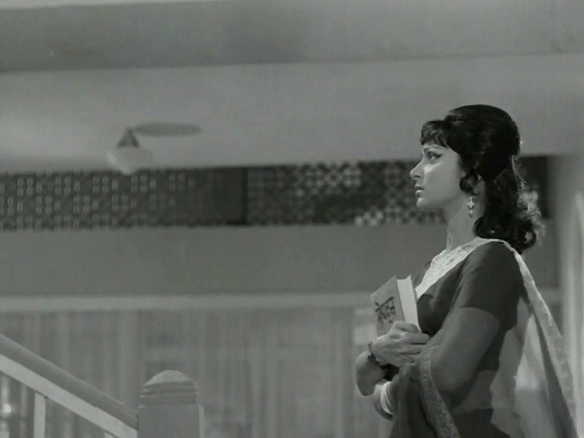
Waheeda Rehman hesitates at the bottom of a staircase leading to the man she loves in Khamoshi (1968).
For our next post we present the full lyrics and translation to the hauntingly beautiful “Tum Pukar Lo” from Khamoshi (1968). This song easily makes my list of most powerful and stirring picturizations from Bollywood. The stark black-and-white imagery highlights the emptiness of space, of shadows, and symbolic barriers. Most of all, the graceful shots that linger longer than action alone permits serve to create a new environment–a world of waiting where time slows down and the confines of the hospital become both escapist and imprisoning. I loved and still love the opening dolly shot so much that I attempted to recreate it in my final film project junior year of Harvard. The shot is transformative–literally taking the audience from behind bars to the free world, and Waheeda from the restraint of her conscience to the new life that beckons her above the staircase. A gentle wind miraculously flows down from Dharmendra’s balcony, through the barren corridor, down the grand stairs, and ultimately through Waheeda’s saari palluu giving rise to a simple, evocative image of a woman drawn by a force greater than any danger: love.
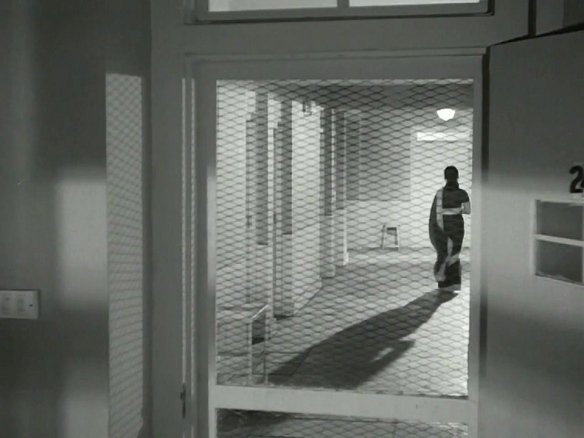
I LOVE the classic “frame-within-a-frame” of the mis-en-scene. Not how the lighting in this sequence informs the trajectory of the characters–recall that prior to Waheeda’s discouragement, the welcoming light source came from the balcony (now shrouded in obscurity), indicating a change in both destination and mindset.
I’ve broken down the dolly shot into 3 parts with my storyboard sketches to give you a full picture of how a shot like this is pulled off. The timing and fluidity of the dolly movement (and the pull focus) must be perfectly coordinated with the pace of the actresses walk as the camera additionally swivels on its own axis tracking her ascent up the stairs. I can only say after having attempting to do this shot myself, that it’s a headache but the effect is absolutely wonderful. Ultimately, Khamoshi is a film about identity and the silence caused by its loss through love. The misappropriated gazes in the film that lead characters in and out of a world of insanity is moving and tragic–and the audience too becomes implicit in that beautiful slippage of reality through Kamal Bose’s stunning cinematography, which won him the Filmfare award in 1968! Like Khamoshi’s characters, the camera lingers in each constructedly bereft space, longing for something more.
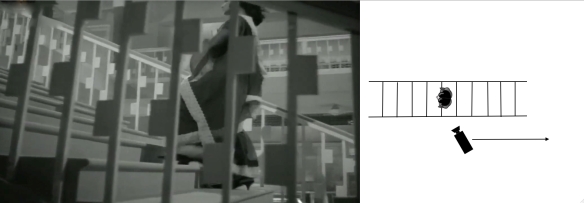
The camera swivels midway through the dolly pull at a low-angle as the rails of the staircase form a figurative cage around the actress.
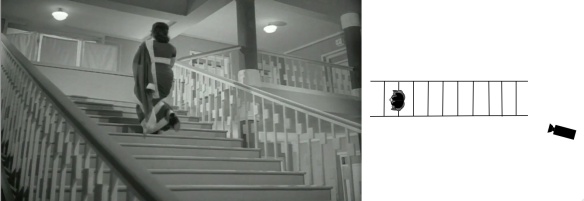
The dolly track at last ends at the base of the staircase, holding the shot after Waheeda leaves the stairs, underscoring the incredible emptiness of the rigid space she inhabits–and her escape from it.
You won’t see much of Dharmendra, the mystery man and asylum inpatient, who sings this song. Instead you see only his outline against the balcony of their confinement. And of course, anything else would be imperfect–while this, this unfulfilled gaze of love, is precisely the poetic complement to the yearning expressed in Gulzar’s heartfelt lyrics. This song may be my favorite Hemant Kumar solo with a melody that hangs in the air long after the song is finished. Whether or not it beats Rajesh Khanna lip-syncing “Woh Shaam Kuch Ajeeb Thi” from the same film is up to you to decide!
Without further ado, see for yourself why this song has become immortal. Follow along with the video here, and we hope you enjoy the lyrics and full English translation to “Tum Pukar Lo” below!
Tum Pukar Lo Lyrics and Translation:
Tum pukaar lo
Call out to me
Tumhaaraa intezaar hai
I am waiting for you
Tum pukar lo
Call out to me
Khwaab chun rahe hai.N raat beqaraar hai
I am sifting through dreams while the night remains restless
Tumhaaraa intezaar hai
I am waiting for you
Tum pukaar lo
Call out to me
HonTh se liye hue dil ki baat hum
The words in my heart have escaped from my lips
Jaagte rahe.nge aur kitne raat hum?
How many more nights will I remain awake like this?
Mukhtasar si baat hai: tumse pyaar hai
The matter is simple: I love you
Tumhaaraa intezaar hai
I am waiting for you
Tum pukaar lo
Call out to me
Dil bahal to jaayegaa is khayaal se
My heart will be content with this thought
Haal mil gaya tumhaaraa apne haal se
That my well-being becomes yours
Raat yeh qaraar ki beqaraar hai
This restful night remains restless
Tumhaaraa intezaar hai
I am waiting for you
Tum pukaar lo
Call out to me
Glossary:
pukaarnaa: to call; intezaar karna: to wait; khvaab: dream; beqaraar: restless; honTh: lips; mukhtasar: brief, short; bahal: content; khayaal: thought; haal: well-being, state; qaraar: restful, quiet
My favorite line of this song is by far “Mukhtasar si baat hai, tum se pyaar hai!” So romantic and God, how I love an understatedly accurate pronunciation of the Urdu khe! However, I’m afraid this is one of those cases in which no matter how you translate it, the beauty of the line is just lost in the bluntness of English.
– Mrs. 55

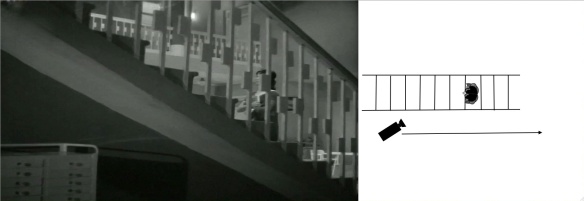
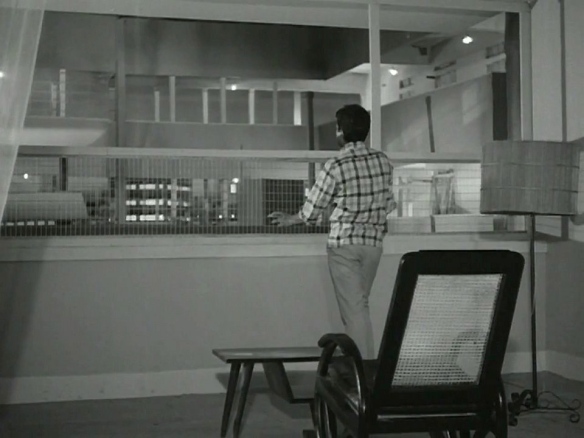
Amazing song, haunting vocals and picturization of the ethereal Waheeda. So interesting learning about the camera technique and breaking it down shot by shot and the thematic implications. Thank you for this!
Glad you enjoyed it! Waheeda always added class to any film–the way she moves down the corridor, it’s as if she’s floating!
Love, love, love this song! Hauntingly beautiful in every way. It is just one of the best!
Great great song and picturisation.. couldnt agree more with the line mukhtasar si baat hai..beautiful.
This one has better picturisation but woh shaam is a better song for me…
See, this is why I like your site so much – translations are secondary (since I have a Hindi-speaking background)… It is all the insights, technical details, snippets, background research, etc. you put into each post that make me look forward to your next one. All your hardwork, mixed with a little humor & occasional irreverance ….one always learns something new ! And, last but not least, your choice of songs & topics is truly good 🙂
I love this song & have watched it many times over the years. However, my appreciation has increased after your explanation of camerawork, etc.
And the lyrics apply to Both the characters, despite the situation. I feel more for Waheeda’s character in this song [& she has portrayed her emotions & expressions so poignantly]. A very nostalgic aura about the song.
While all songs in this film are superb, I especially like “humne dekhi hai in aankhon kii ….” — classic Gulzar (& arguably his best philosophically speaking?) ! Of course, nothing much from picturisation angle.
An extremely good post, mr & mrs 55 !
Thank you for your great comments! There is a strong sense of nostalgia in this song–it’s one of our favorites! I also LOVE “Humne Dekhi Hai” from the same film–Khamoshi was one of the musical greats of its era. Stay tuned for another translation and thanks for reading!
Reblogged this on abhsing4 and commented:
Eternal Favourite , would stay the same..
Its a great blog! Love the translations. Can’t help but spread the word 🙂
Shared these lyrics on my blogpost as well – http://shrimati420.wordpress.com
Thank you Shrimati 420! This is one of our favorite songs as well!
Hello there!!
I’ve been a regular to your blog since more than a year now… I love your vivid explanations of the songs, more than the actual translation, because despite being a TamBram, I’ve been born and brought up in Gujarat, so I know my Hindi well..
I have always loved this song but have only seen this movie maybe once or twice (Because I can’t tolerate the end.. It’s too heart-wrenching for me!). So… yeah.. your explanation of the dolly shot was quite a revelation.. 🙂
I have just one input on the translation though: the line “HonTh se liye hue dil ki baat hum (The words in my heart have escaped from my lips)” should actually be “HonTh PE liye hue dil ki baat hum (Carrying the words of my heart, on my lips)… It is in line with the oft-repeated Hindi statement that Dil ki baat honthon pe reh gayi..
It’s great to hear from a long-time follower! This song has always been one of my favorites…and can still move me to tears. Thank you for adding an interpretation of the line “honTh se liye hue”–there are many ways to translate these lovely lyrics depending on taste. We appreciate your kind words and thanks for sharing!
Pingback: Beqarar Karke Humen Lyrics and Translation: Let’s Learn Urdu-Hindi | Mr. & Mrs. 55 - Classic Bollywood Revisited!
I’m enjoying your site! I just wanted to add that this song is a remake of a Bangla song from a 1959 film “Deep Jwele Jai” https://en.wikipedia.org/wiki/Deep_Jwele_Jaai
It’s also filmed similarly to the original scene in Deep Jwele Jaai. I actually like the melody of the Bangla version better – you should check it out, I think you’d like it! It’s also sung by Hemanta Mukherjee
https://www.youtube.com/watch?v=11R6hhYy5Ho
Thanks for the site & translations 🙂